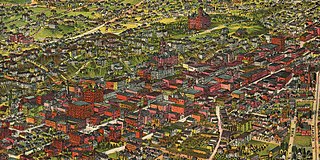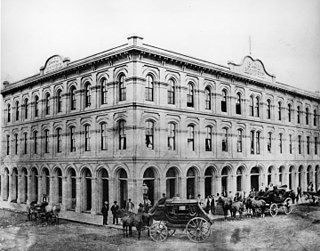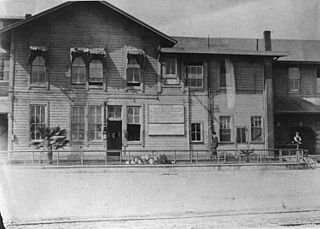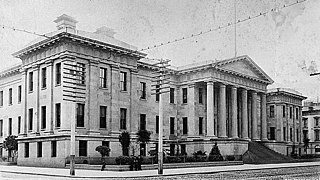 W
W15 Union Square West is a residential building on East 15th Street overlooking Union Square in Manhattan, New York City. Originally Tiffany & Company’s 19th-century headquarters, it was refurbished and reopened in 2008 as high-end apartments.
 W
WThe Edward G. Acheson House is a historic house at 908 West Main St. in Monongahela, Washington County, Pennsylvania, United States. Probably built about 1870, it is notable as the home of Edward G. Acheson (1856-1931), the inventor of carborundum, and as the likely site of its invention. It was designated a National Historic Landmark in 1976.
 W
WThe late-Victorian-era Downtown of Los Angeles grew year by year, around 1880 centered at the southern end of the Los Angeles Plaza area, and over the next two decades, extending south and west along Main Street, Spring Street, and Broadway towards Third Street. Most of the 19th-century buildings no longer exist, surviving only in the Plaza area or south of Second Street. The rest were demolished to make way for the Civic Center district with City Hall, numerous courthouses, and other municipal, county, state and federal buildings, and Times Mirror Square. This article covers that area, between the Plaza, 3rd St., Los Angeles St., and Broadway, during the period 1880 through the period of demolition (1920s–1950s).
 W
WThe Carson City Mint was a branch of the United States Mint in Carson City, Nevada. It primarily minted silver coins; however, it also minted gold coins, with a total face value in dollars nearly equal to that of its silver coins. The mint minted coins in 21 different years.
 W
WThe Cathedral of Saint Vibiana, often called St. Vibiana's, is a former cathedral church building and parish of the Roman Catholic Archdiocese of Los Angeles. Located in Downtown Los Angeles, the building opened in 1876 as the cathedral for what was then known as the Diocese of Monterey-Los Angeles, and remained the official cathedral of the Los Angeles see for over 100 years.
 W
WThe late-Victorian-era Downtown of Los Angeles grew year by year, around 1880 centered at the southern end of the Los Angeles Plaza area, and over the next two decades, extending south and west along Main Street, Spring Street, and Broadway towards Third Street. Most of the 19th-century buildings no longer exist, surviving only in the Plaza area or south of Second Street. The rest were demolished to make way for the Civic Center district with City Hall, numerous courthouses, and other municipal, county, state and federal buildings, and Times Mirror Square. This article covers that area, between the Plaza, 3rd St., Los Angeles St., and Broadway, during the period 1880 through the period of demolition (1920s–1950s).
 W
WThe Federal Building, also known as the Century Post Office, is a historic building located on Fayetteville Street in Raleigh, Wake County, North Carolina. It was the first Federal Government project in the South following the Civil War. Construction of the building began in 1874 and was completed in 1878. The building's Second Empire design was by Alfred B. Mullett whose more famous works included the Old Executive Office Building located near the White House. The Federal Building was listed on the National Register of Historic Places in 1971 and is a Raleigh Historic Landmark.
 W
W1879 Houston Waterworks is a building located in Houston, Texas listed on the National Register of Historic Places.
 W
WMadison Square Garden (1879–1890) was an arena in New York City at the northeast corner of East 26th Street and Madison Avenue in Manhattan. The first venue to use that name, it seated 10,000 spectators. It was replaced with a new building on the same site.
 W
WMain Mall Row is an adjoining group of nine commercial buildings along the northeast corner of the intersection of Main and Garden streets in downtown Poughkeepsie, New York, United States. They were mostly built after a fire in 1870 destroyed the previous buildings on the site. The new structures were three-to-four story buildings in the Renaissance Revival style, many with ornamental touches such as bracketed cornices, paneled friezes, arcaded facades and molded lintels. 315 Main Mall, at the east end, has an ornate cast iron facade. They are considered among the most architecturally significant commercial buildings in the city, and are still in use as stores today. The building at 3-9 Garden Street retains its original storefronts. The row, as with many of the other buildings in downtown Poughkeepsie, was added to the National Register of Historic Places in 1982.
 W
WThe Peabody Museum of Archaeology and Ethnology is a museum affiliated with Harvard University in Cambridge, Massachusetts. Founded in 1866, the Peabody Museum is one of the oldest and largest museums focusing on anthropological material, with particular focus on the ethnography and archaeology of the Americas. The museum is caretaker to over 1.2 million objects, some 900 linear feet of documents, 2,000 maps and site plans, and approximately 500,000 photographs. The museum is located at Divinity Avenue on the Harvard University campus. The museum is one of the four Harvard Museums of Science & Culture open to the public.
 W
WThe Pico House is a historic building in Los Angeles, California, dating from its days as a small town in Southern California. Located on 430 North Main Street, it sits across the old Los Angeles Plaza from Olvera Street and El Pueblo de Los Ángeles Historical Monument.
 W
WRiver Station was a Southern Pacific Railroad passenger station location, southwest of the Los Angeles River on San Fernando Road and north of Downtown, in Los Angeles, California. The site is within the present day Los Angeles State Historic Park.
 W
WSt. Mary is a Roman Catholic church in Norwalk, Connecticut, part of the Diocese of Bridgeport. As the first Catholic Church in Norwalk from which three other parishes developed, St. Mary's is considered the Mother Church of Norwalk.
 W
WSt. Mary's Church is a historic former Catholic church in the Lawrenceville of Pittsburgh, Pennsylvania. It was built in 1874 and was added to the List of Pittsburgh History and Landmarks Foundation Historic Landmarks in 1971. The St. Mary's Church property also includes the St. Mary's Academy building, a Pittsburgh historic landmark.
 W
WThe San Francisco Mint is a branch of the United States Mint and was opened in 1854 to serve the gold mines of the California Gold Rush. It quickly outgrew its first building and moved into a new one in 1874. This building, the Old United States Mint, also known affectionately as The Granite Lady, is one of the few that survived the great 1906 San Francisco earthquake. It served until 1937, when the present facility was opened.
 W
WThe Warren First Congregational Church-Federated Church is an American historic church building, located at 25 Winthrop Terrace in Warren, Massachusetts.
 W
WWhite Oak Hall, also known as White Oak School, is a historic building located near Rushville, Illinois, United States. The two-story school was built in 1874. The first floor of the building held the schoolroom, while the second floor was used as a meeting hall by the local chapter of The Grange. The Grange Hall also housed the White Oak Literary Society, church services, Sunday school classes, and social functions. The school operated until 1960, while the second floor was used for events through the 1990s. The school is one of the only rural one-room schoolhouses remaining in Schuyler County.